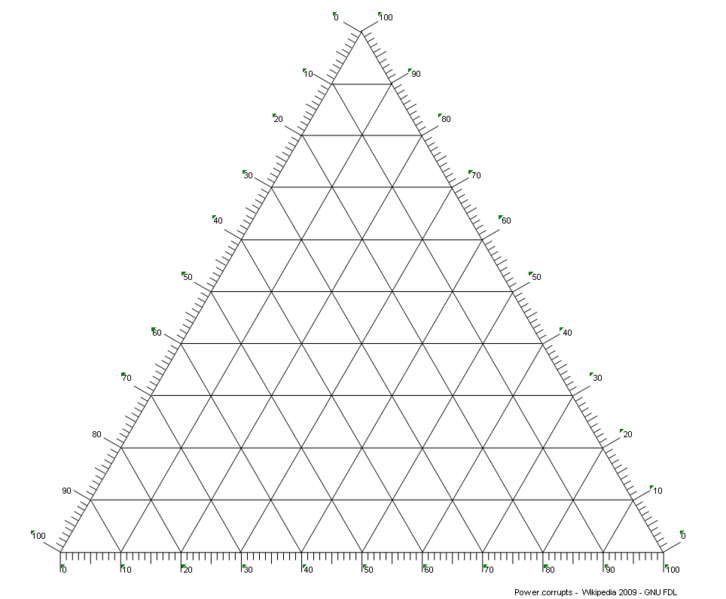构造三元网格,在Matlab中评估网格和等高线图上的函数
我需要评估一个函数(比方说) Fxy = 2 * x。^ 2 + 3 * y。^ 2; 在三元网格x范围(0-1),y范围(0-1)和1-x-y(0-1)上。 我无法构建我需要评估上述函数的三元网格。此外,一旦评估,我需要在三元等高线图中绘制函数。理想情况下,我需要轴在这个意义上逆时针方向(x - > y - >(1-x-y))。
我试过了这个功能
function tg = triangle_grid ( n, t )
ng = ( ( n + 1 ) * ( n + 2 ) ) / 2;
tg = zeros ( 2, ng );
p = 0;
for i = 0 : n
for j = 0 : n - i
k = n - i - j;
p = p + 1;
tg(1:2,p) = ( i * t(1:2,1) + j * t(1:2,2) + k * t(1:2,3) ) / n;
end
end
return
end
表示三角形边坐标之间的子间隔数
n = 10 (say)
和等边三角形的边坐标
t = tcoord = [0.0, 0.5, 1.0;
0.0, 1.0*sqrt(3)/2, 0.0];
这产生了一个三角形网格,x轴从0到1,但另外两个不是0-1。
我需要这样的东西:

...轴的范围为0-1( 0-100也可以)。
另外,我需要知道三角形网格内所有交叉点的坐标点。有了这个,我就可以继续评估这个网格中的功能了。
我的最终目标是获得这样的东西。这是我需要实现的更好的表示(与我之前删除的之前的情节相比)
请注意,两个三元图具有等值不同的等值线。在我的情况下,差异是一个数量级,两个非常不同的Fxy。
如果我可以将两个三元图绘制在彼此之上,然后评估三元平面上两个等值线轮廓交叉处的成分。组成应该从三元图中读取,而不是定义三角形的矩形网格。 目前存在一些问题(如评论部分中所强调的,一旦问题更接近解决方案,将更新此问题)。
3 个答案:
答案 0 :(得分:2)
I have played a bit with the file exchange submission https://www.mathworks.com/matlabcentral/fileexchange/2299-alchemyst-ternplot.
if you just do this:
[x,y]=meshgrid(0:0.1:1);
Fxy = 2*x.^2 +3 *y.^2;
ternpcolor(x(:),y(:),Fxy(:))
You get:
The thirds axis is created exactly as you say (1-x-y) inside the ternpcolor function. There are lots of things to "tune" here but I hope it is enough to get you started.
答案 1 :(得分:2)
我是ternplot的作者。正如您所推测的那样,ternpcolor并不能满足您的需求,因为它是自动构建的网格数据。回想起来,这不是一个特别明智的决定,我made a note改变了设计。同时,此代码应该按照您的要求执行:
编辑:我已经更改了代码以找到两条曲线的交集而不只是一条曲线。
N = 10;
x = linspace(0, 1, N);
y = x;
% The grid intersections on your diagram are actually rectangularly arranged,
% so meshgrid will build the intersections for us
[xx, yy] = meshgrid(x, y);
zz = 1 - (xx + yy);
% now that we've got the intersections, we can evaluate the function
f1 = @(x, y) 2*x.^2 + 3*y.^2 + 0.1;
Fxy1 = f1(xx, yy);
Fxy1(xx + yy > 1) = nan;
f2 = @(x, y) 3*x.^2 + 2*y.^2;
Fxy2 = f2(xx, yy);
Fxy2(xx + yy > 1) = nan;
f3 = @(x, y) (3*x.^2 + 2*y.^2) * 1000; % different order of magnitude
Fxy3 = f3(xx, yy);
Fxy3(xx + yy > 1) = nan;
subplot(1, 2, 1)
% This constructs the ternary axes
ternaxes(5);
% These are the coordinates of the compositions mapped to plot coordinates
[xg, yg] = terncoords(xx, yy);
% simpletri constructs the correct triangles
tri = simpletri(N);
hold on
% and now we can plot
trisurf(tri, xg, yg, Fxy1);
trisurf(tri, xg, yg, Fxy2);
hold off
view([137.5, 30]);
subplot(1, 2, 2);
ternaxes(5)
% Here we plot the line of intersection of the two functions
contour(xg, yg, Fxy1 - Fxy2, [0 0], 'r')
axis equal
编辑2:如果要找到两个轮廓之间的交点,则可以有效地求解两个联立方程。这段额外的代码将为您解决(注意我现在在上面的代码中使用了一些匿名函数):
f1level = 1;
f3level = 1000;
intersection = fsolve(@(v) [f1(v(1), v(2)) - f1level; f3(v(1), v(2)) - f3level], [0.5, 0.4]);
% if you don't have the optimization toolbox, this command works almost as well
intersection = fminsearch(@(v) sum([f1(v(1), v(2)) - f1level; f3(v(1), v(2)) - f3level].^2), [0.5, 0.4]);
ternaxes(5)
hold on
contour(xg, yg, Fxy1, [f1level f1level]);
contour(xg, yg, Fxy3, [f3level f3level]);
ternplot(intersection(1), intersection(2), 1 - sum(intersection), 'r.');
hold off
答案 2 :(得分:0)
以下是使用R和我的包ggtern的解决方案。为了进行比较,我还在下方附近包括了点。
library(ggtern)
Fxy = function(x,y){ 2*x^2 + 3*y^2 }
x = y = seq(0,1,length.out = 100)
df = expand.grid(x=x,y=y);
df$z = 1 - df$x - df$y
df = subset(df,z >= 0)
df$value = Fxy(df$x,df$y)
#The Intended Breaks
breaks = pretty(df$value,n=10)
#Create subset of the data, within close proximity to the breaks
df.sub = ldply(breaks,function(b,proximity = 0.02){
s = b - abs(proximity)/2; f = b + abs(proximity)/2
subset(df,value >= s & value <= f)
})
#Plot the ternary diagram
ggtern(df,aes(x,y,z)) +
theme_bw() +
geom_point(data=df.sub,alpha=0.5,color='red',shape=21) +
geom_interpolate_tern(aes(value = value,color=..level..), size = 1, n = 200,
breaks = c(breaks,max(df$value) - 0.01,min(df$value) + 0.01),
base = 'identity',
formula = value ~ poly(x,y,degree=2)) +
labs(title = "Contour Plot on Modelled Surface", x = "Left",y="Top",z="Right")
产生以下内容:
- 我写了这段代码,但我无法理解我的错误
- 我无法从一个代码实例的列表中删除 None 值,但我可以在另一个实例中。为什么它适用于一个细分市场而不适用于另一个细分市场?
- 是否有可能使 loadstring 不可能等于打印?卢阿
- java中的random.expovariate()
- Appscript 通过会议在 Google 日历中发送电子邮件和创建活动
- 为什么我的 Onclick 箭头功能在 React 中不起作用?
- 在此代码中是否有使用“this”的替代方法?
- 在 SQL Server 和 PostgreSQL 上查询,我如何从第一个表获得第二个表的可视化
- 每千个数字得到
- 更新了城市边界 KML 文件的来源?




